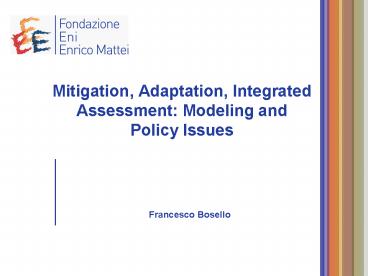Mitigation, Adaptation, Integrated Assessment: Modeling and Policy Issues PowerPoint PPT Presentation
1 / 13
Title: Mitigation, Adaptation, Integrated Assessment: Modeling and Policy Issues
1
Mitigation, Adaptation, Integrated Assessment
Modeling and Policy Issues
Francesco Bosello
2
Two ways to integrate climate and economics Hard
vs Soft Link
- Hard-linked climate-economic models
Climate and economics treated as a unified
system represented by a consistent set of
differential (climatic economic) equations.
Emissions build CO2 concentration stock and
temperature. A (more or less refined) damage
function translates temperature increase into GDP
losses.
Emissions
Mitgation
Economic system
Climate system
Adaptation
Damages
Soft-linked climate-economic models
O
I
Mitgation
Environm. impact module(s)
Economic Impact module(s)
Economic Assessment
O
O
O
Climate System
I
I
Adaptation
Climate, environment and economics treated
separately. Outputs of climate models are inputs
to environmental impact modules. Outputs of
environmental impact modules are inputs to
economic impact modules ? these provide final
economic assessment. Inputs and outputs need to
be translated in the different languages used
by different models/disciplines
3
Hard vs Soft link, strengths and weaknesses
- Hard-linked
Soft-linked
Climate environmental economic details
Necessarily simplyfied high aggregation
Can be very high high disaggregation
Fully consistent and integrated
Links and feedback
The feedback loops are not necessarily closed
Time treatment
Simplyfied usually (comparative) static or
recursive-dynamic
Refined usually full intertemporal optimization
Policy perspective
Better suited for policy optimisation
Better suited for policy evaluation
IPCC approach emissions scenarios stem from
exogenous storylines proposed by/incorporated in
a set of soft-linked models. Problematic for hard
linked models where the storyline is
endogenously embedded replicating soft linked
emissions may gt unrealistic economic
assumptions, or using model-consistent economic
assumptions may gt different emissions paths! ?
Crucial for policy perscriptions!!
The scenario Issue!!
4
Room for fruitful integration summarizing
A hard linked model can generate emissions or
temperature increases in a fully consistent
climate-economic framework.
A soft linked approach can be used to
economically assess climate change impacts from
those emissions with a great country and sectoral
detail and taking into account adjustments in
national and international markets due to changes
in relative prices (i.e. autonomous adaptation).
These detailed information on climate change
damages can be used to parameterise the
aggregated damage function of a hard linked
system. The same can hold for the
parameterisation of cost and benefit of an
adaptation function.
Finally a hard linked model can be used to
determine optimal level of mitigation and
adaptation and optimal mix between these two
strategies.
5
e.g. WITCH and ICES
Hard-link integrated economic-environment model,
full dynamic optimization, 12 regions and
strategic behaviors (game theory approach),
endogenous technical change, bottom-up treatment
of energy sector (electric and non electric
energy use, 6 fuels, 7 different technologies for
electricity generation). Damage function
temperature decreases GDP. Mitigation costs, but
reduces emissions and damages. The model
determines optimal abatement, optimal investment,
optimal RD, optimal energy mix. Single
industry model (no international trade on
goods).
Multisector (up to 66) multi country (up to 87)
recursive-dynamic top down CGE model with
international trade and capital mobility. An
explicit climate change damage function does not
exist climate change impacts translated into
environmental impacts translated into economic
shocks, originate market adjustments (resources
re-allocation) whose final GDP and sectoral
effect is assessed. Autonomous adaptation
intrinsically considered. Mitigation accounted
for by carbon taxes.
6
WITCH, ICES and adaptation
Autonomous adaptation cannot be explicitly
modelled.
Planned adaptation can be modelled (see after) as
a strategy that decreases through appropriate
modification of the damage function, the negative
impact of temperature increase on GDP ? High
aggregation sectoral dymension cannot be
captured
The optimising framework of the model allows to
determine optimal level of adaptation and optimal
mix of adaptation and mitigation
The role of autonomous adaptation is an
intrinsic output of the model the impact on GDP
originated by a climate change pressure (e.g land
lost to sea level rise) takes into account market
substitution mechanisms. Direct impact ? final
impact
Planned adaptation can be modelled at the
sectoral level. E.g. GDP implication of increased
health care or coastal defence expenditure, etc.
It is not possible to define endogenously an
optimal and time consistent level of adaptation
or mix adaptation-mitigation
7
Room for fruitful integration WITCH _at_ ICES
Endogenous internally consistent economic
storylines
- GDP growth, - Tech. change scenarios, -
Long-term natural resources prices etc.
bottom-up treatment of planned adaptation (and
mitigation) ? parameterization of adaptation
(mitigation) functions
Optimal policy analysis
Endogenous Emission Scenarios
(Economic assessment of) climate change impacts
with autonomous adaptation and high
sectoral/country detail ? new parameterization of
WITCH damage function
8
From emission target, to conc. target, to
temperature target, to damage target?
9
Impact studies
CC impacts on biodiversity under developmen
Under development
Under development
Done
Done
10
Climate Impacts
1.5º C temperature increase in 2050 wrt 1980-1999
average ( change wrt baseline)
11
The global picture
12
Impact ranking
13
corso Magenta 63 20123 Milano - Italy tel 39
02 5203.6975 fax 39 02 5203.6946 web http/
/www.feem.it

